2014 FORD FOCUS ELECTRIC seats
[x] Cancel search: seatsPage 2 of 403
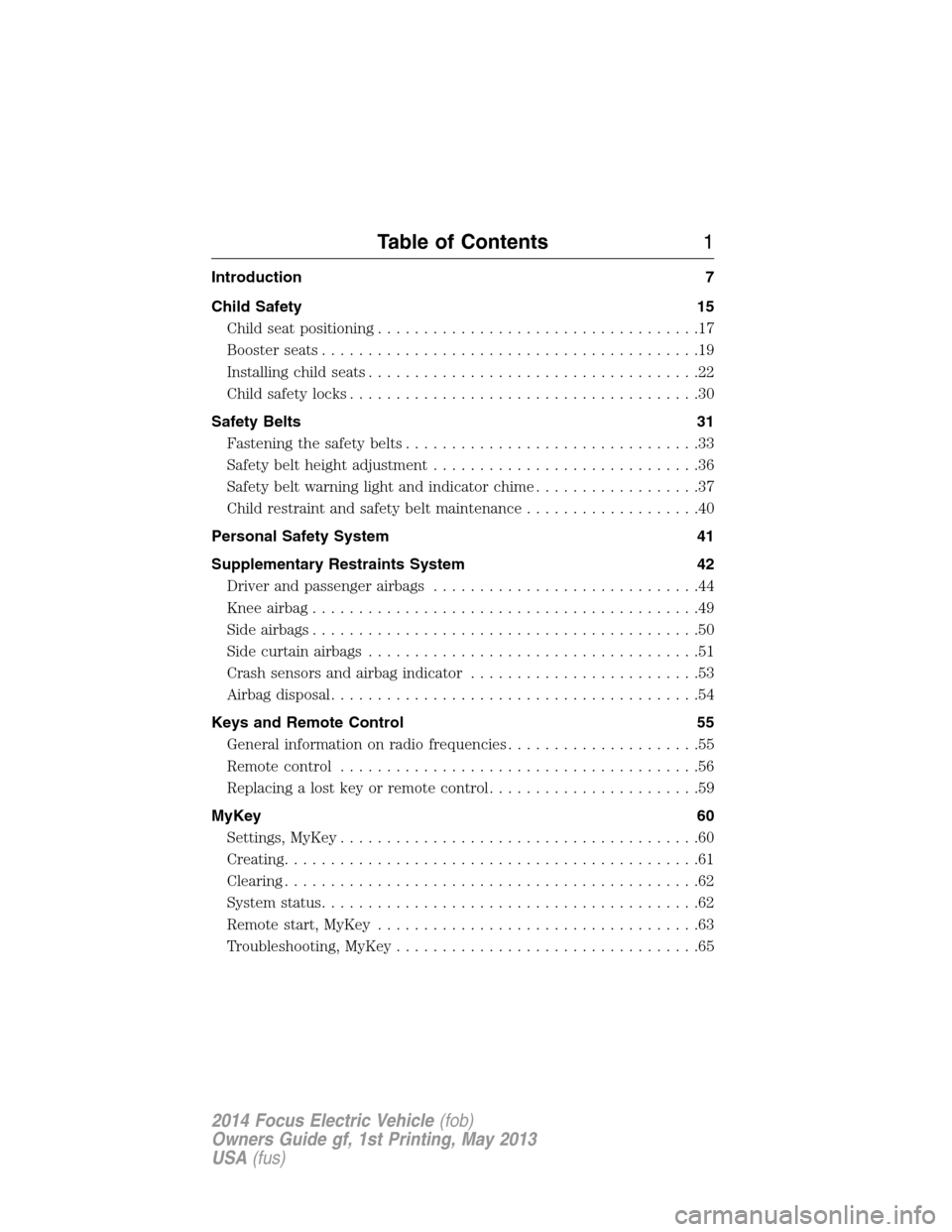
Introduction 7
Child Safety 15
Child seat positioning...................................17
Booster seats.........................................19
Installing child seats....................................22
Child safety locks......................................30
Safety Belts 31
Fastening the safety belts................................33
Safety belt height adjustment.............................36
Safetybeltwarninglightandindicatorchime..................37
Child restraint and safety belt maintenance...................40
Personal Safety System 41
Supplementary Restraints System 42
Driver and passenger airbags.............................44
Knee airbag..........................................49
Side airbags..........................................50
Side curtain airbags....................................51
Crash sensors and airbag indicator.........................53
Airbag disposal........................................54
Keys and Remote Control 55
General information on radio frequencies.....................55
Remote control.......................................56
Replacing a lost key or remote control.......................59
MyKey 60
Settings, MyKey.......................................60
Creating.............................................61
Clearing.............................................62
System status.........................................62
Remote start, MyKey...................................63
Troubleshooting, MyKey.................................65
Table of Contents1
2014 Focus Electric Vehicle(fob)
Owners Guide gf, 1st Printing, May 2013
USA(fus)
Page 4 of 403

Information Displays 102
Message center.......................................102
Information messages..................................110
Climate Control 120
Rear window defroster.................................124
Seats 127
Sitting in the correct position............................127
Head restraints.......................................128
Manual seats........................................131
Power seats.........................................133
Heated seats........................................134
Rear seats..........................................135
Auxiliary Power Points 137
Storage Compartments 138
Overhead console.....................................138
Starting and Stopping the Vehicle 139
Keyless starting......................................139
High Voltage Battery 142
High-voltagebattery...................................142
Charging the high-voltage battery.........................142
High-voltageshut-off...................................148
Transmission 149
Automatic transmission.................................149
Hill start assist.......................................152
Brakes 153
Brakes.............................................153
Hints on driving with anti-lock brakes......................154
Parking brake........................................155
Table of Contents3
2014 Focus Electric Vehicle(fob)
Owners Guide gf, 1st Printing, May 2013
USA(fus)
Page 6 of 403
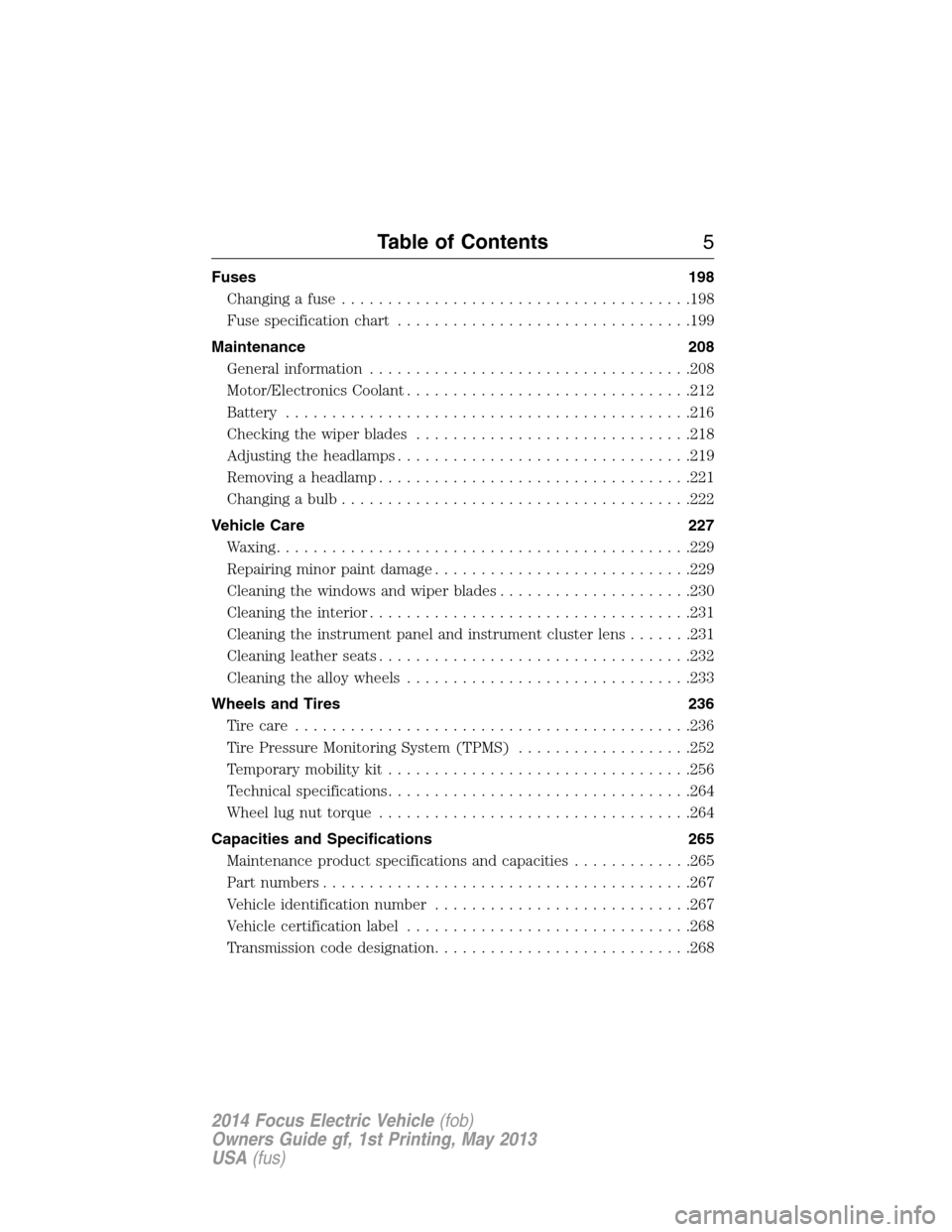
Fuses 198
Changing a fuse......................................198
Fuse specification chart................................199
Maintenance 208
General information...................................208
Motor/Electronics Coolant...............................212
Battery ............................................216
Checking the wiper blades..............................218
Adjusting the headlamps................................219
Removing a headlamp..................................221
Changing a bulb......................................222
Vehicle Care 227
Waxing.............................................229
Repairing minor paint damage............................229
Cleaning the windows and wiper blades.....................230
Cleaning the interior...................................231
Cleaning the instrument panel and instrument cluster lens.......231
Cleaning leather seats..................................232
Cleaning the alloy wheels...............................233
Wheels and Tires 236
Tire care...........................................236
Tire Pressure Monitoring System (TPMS)...................252
Temporary mobility kit.................................256
Technical specifications.................................264
Wheel lug nut torque..................................264
Capacities and Specifications 265
Maintenance product specifications and capacities.............265
Part numbers........................................267
Vehicle identification number............................267
Vehicle certification label...............................268
Transmission code designation............................268
Table of Contents5
2014 Focus Electric Vehicle(fob)
Owners Guide gf, 1st Printing, May 2013
USA(fus)
Page 14 of 403
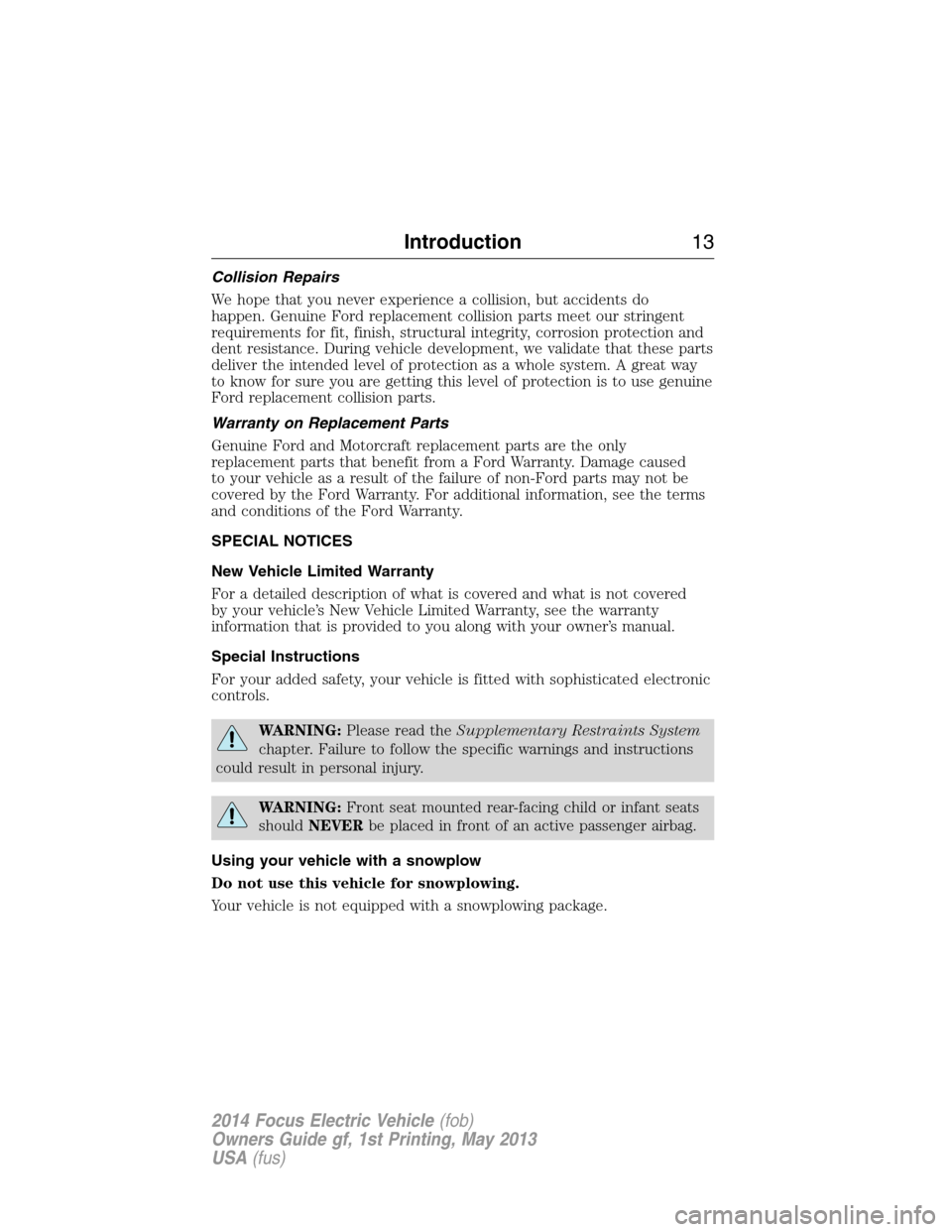
Collision Repairs
We hope that you never experience a collision, but accidents do
happen. Genuine Ford replacement collision parts meet our stringent
requirements for fit, finish, structural integrity, corrosion protection and
dent resistance. During vehicle development, we validate that these parts
deliver the intended level of protection as a whole system. A great way
to know for sure you are getting this level of protection is to use genuine
Ford replacement collision parts.
Warranty on Replacement Parts
Genuine Ford and Motorcraft replacement parts are the only
replacement parts that benefit from a Ford Warranty. Damage caused
to your vehicle as a result of the failure of non-Ford parts may not be
covered by the Ford Warranty. For additional information, see the terms
and conditions of the Ford Warranty.
SPECIAL NOTICES
New Vehicle Limited Warranty
For a detailed description of what is covered and what is not covered
by your vehicle’s New Vehicle Limited Warranty, see the warranty
information that is provided to you along with your owner’s manual.
Special Instructions
For your added safety, your vehicle is fitted with sophisticated electronic
controls.
WARNING:Please read theSupplementary Restraints System
chapter. Failure to follow the specific warnings and instructions
could result in personal injury.
WARNING:Front seat mounted rear-facing child or infant seats
shouldNEVERbe placed in front of an active passenger airbag.
Using your vehicle with a snowplow
Do not use this vehicle for snowplowing.
Your vehicle is not equipped with a snowplowing package.
Introduction13
2014 Focus Electric Vehicle(fob)
Owners Guide gf, 1st Printing, May 2013
USA(fus)
Page 16 of 403
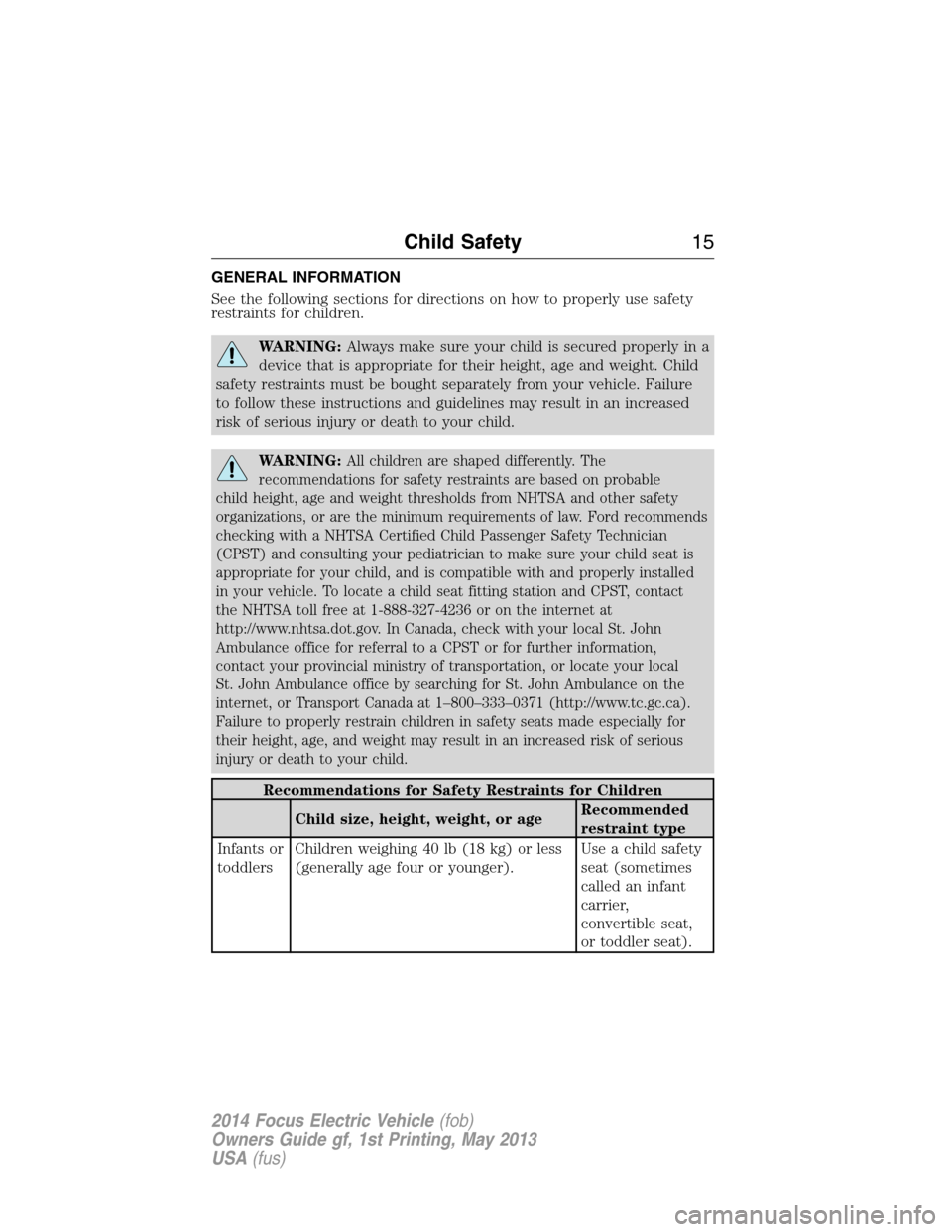
GENERAL INFORMATION
See the following sections for directions on how to properly use safety
restraints for children.
WARNING:Always make sure your child is secured properly in a
device that is appropriate for their height, age and weight. Child
safety restraints must be bought separately from your vehicle. Failure
to follow these instructions and guidelines may result in an increased
risk of serious injury or death to your child.
WARNING:All children are shaped differently. The
recommendations for safety restraints are based on probable
child height, age and weight thresholds from NHTSA and other safety
organizations, or are the minimum requirements of law. Ford recommends
checking with a NHTSA Certified Child Passenger Safety Technician
(CPST) and consulting your pediatrician to make sure your child seat is
appropriate for your child, and is compatible with and properly installed
in your vehicle. To locate a child seat fitting station and CPST, contact
the NHTSA toll free at 1-888-327-4236 or on the internet at
http://www.nhtsa.dot.gov. In Canada, check with your local St. John
Ambulance office for referral to a CPST or for further information,
contact your provincial ministry of transportation, or locate your local
St. John Ambulance office by searching for St. John Ambulance on the
internet, or Transport Canada at 1–800–333–0371 (http://www.tc.gc.ca).
Failure to properly restrain children in safety seats made especially for
their height, age, and weight may result in an increased risk of serious
injury or death to your child.
Recommendations for Safety Restraints for Children
Child size, height, weight, or ageRecommended
restraint type
Infants or
toddlersChildren weighing 40 lb (18 kg) or less
(generally age four or younger).Use a child safety
seat (sometimes
called an infant
carrier,
convertible seat,
or toddler seat).
Child Safety15
2014 Focus Electric Vehicle(fob)
Owners Guide gf, 1st Printing, May 2013
USA(fus)
Page 17 of 403
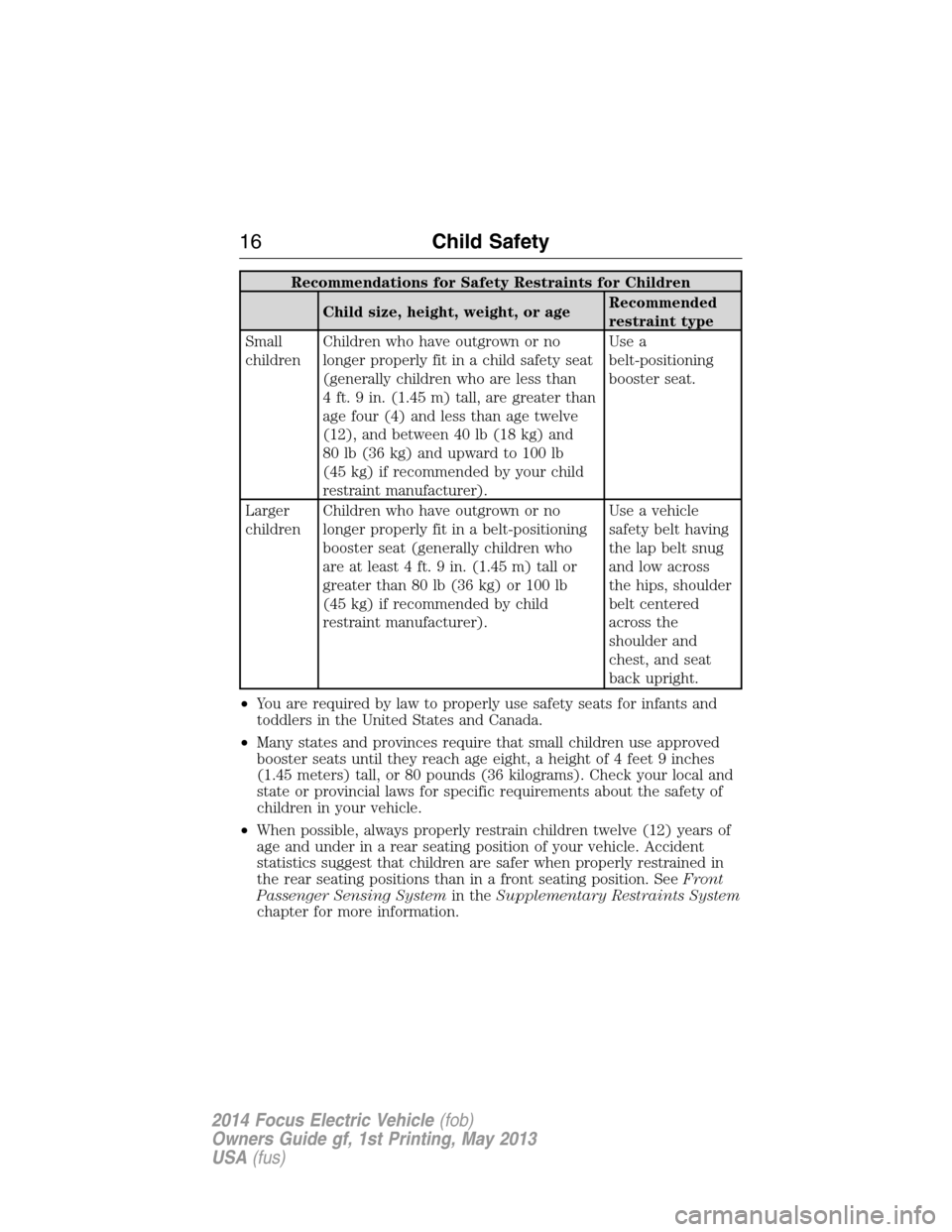
Recommendations for Safety Restraints for Children
Child size, height, weight, or ageRecommended
restraint type
Small
childrenChildren who have outgrown or no
longer properly fit in a child safety seat
(generally children who are less than
4 ft. 9 in. (1.45 m) tall, are greater than
age four (4) and less than age twelve
(12), and between 40 lb (18 kg) and
80 lb (36 kg) and upward to 100 lb
(45 kg) if recommended by your child
restraint manufacturer).Use a
belt-positioning
booster seat.
Larger
childrenChildren who have outgrown or no
longer properly fit in a belt-positioning
booster seat (generally children who
are at least 4 ft. 9 in. (1.45 m) tall or
greater than 80 lb (36 kg) or 100 lb
(45 kg) if recommended by child
restraint manufacturer).Use a vehicle
safety belt having
the lap belt snug
and low across
the hips, shoulder
belt centered
across the
shoulder and
chest, and seat
back upright.
•You are required by law to properly use safety seats for infants and
toddlers in the United States and Canada.
•Many states and provinces require that small children use approved
booster seats until they reach age eight, a height of 4 feet 9 inches
(1.45 meters) tall, or 80 pounds (36 kilograms). Check your local and
state or provincial laws for specific requirements about the safety of
children in your vehicle.
•When possible, always properly restrain children twelve (12) years of
age and under in a rear seating position of your vehicle. Accident
statistics suggest that children are safer when properly restrained in
the rear seating positions than in a front seating position. SeeFront
Passenger Sensing Systemin theSupplementary Restraints System
chapter for more information.
16Child Safety
2014 Focus Electric Vehicle(fob)
Owners Guide gf, 1st Printing, May 2013
USA(fus)
Page 19 of 403
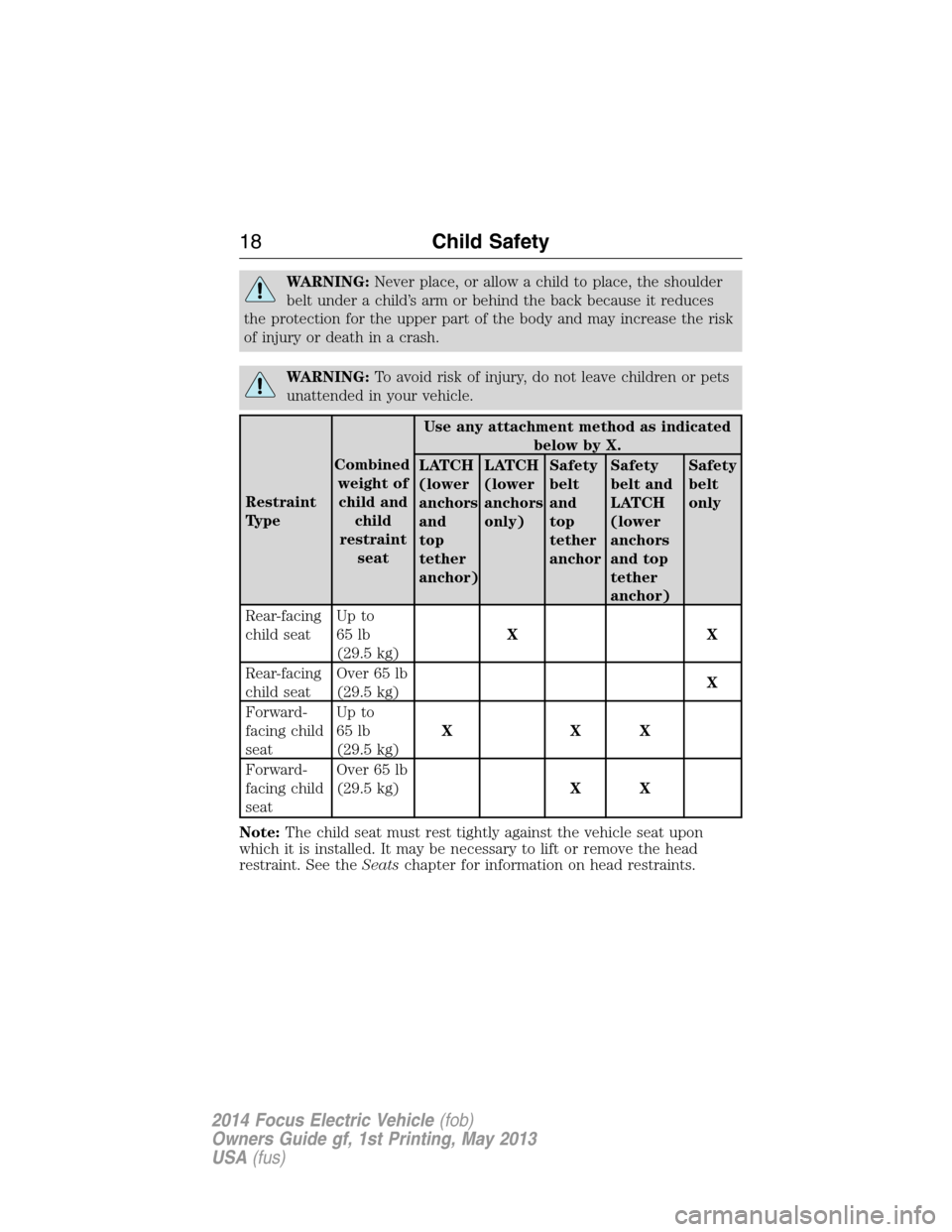
WARNING:Never place, or allow a child to place, the shoulder
belt under a child’s arm or behind the back because it reduces
the protection for the upper part of the body and may increase the risk
of injury or death in a crash.
WARNING:To avoid risk of injury, do not leave children or pets
unattended in your vehicle.
Restraint
TypeCombined
weight of
child and
child
restraint
seatUse any attachment method as indicated
below by X.
LATCH
(lower
anchors
and
top
tether
anchor)LATCH
(lower
anchors
only)Safety
belt
and
top
tether
anchorSafety
belt and
LATCH
(lower
anchors
and top
tether
anchor)Safety
belt
only
Rear-facing
child seatUp to
65 lb
(29.5 kg)XX
Rear-facing
child seatOver 65 lb
(29.5 kg)X
Forward-
facing child
seatUp to
65 lb
(29.5 kg)XXX
Forward-
facing child
seatOver 65 lb
(29.5 kg)XX
Note:The child seat must rest tightly against the vehicle seat upon
which it is installed. It may be necessary to lift or remove the head
restraint. See theSeatschapter for information on head restraints.
18Child Safety
2014 Focus Electric Vehicle(fob)
Owners Guide gf, 1st Printing, May 2013
USA(fus)
Page 20 of 403

BOOSTER SEATS
WARNING:Never place, or allow a child to place, the shoulder
belt under a child’s arm or behind the back because it reduces
the protection for the upper part of the body and may increase the risk
of injury or death in a crash.
Use a belt-positioning booster seat for children who have outgrown or no
longer properly fit in a child safety seat (generally children who are less
than 4 feet 9 inches (1.45 meters) tall, are greater than age four (4) and
less than age twelve (12), and between 40 pounds (18 kilograms) and
80 pounds (36 kilograms) and upward to 100 pounds (45 kilograms) if
recommended by your child restraint manufacturer). Many state and
provincial laws require that children use approved booster seats until
they reach age eight (8), a height of 4 feet 9 inches (1.45 meters) tall, or
80 pounds (36 kilograms).
Booster seats should be used until you can answer YES to ALL of these
questions when the child is seated without a booster seat.
•Can the child sit all the way
back against their vehicle seat
with knees bent comfortably at
the edge of the seat cushion?
•Can the child sit without
slouching?
•Does the lap belt rest low across the hips?
•Is the shoulder belt centered on the shoulder and chest?
•Can the child stay seated like this for the whole trip?
Always use booster seats in conjunction with your vehicle lap and
shoulder belt.
Child Safety19
2014 Focus Electric Vehicle(fob)
Owners Guide gf, 1st Printing, May 2013
USA(fus)